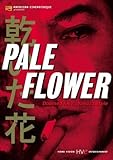Eye For Film >> Movies >> Pale Flower (1964) Film Review
Tokyo, as a bustling metropolis bursting at the seams, forms the backdrop for Japanese New Wave director Masahiro Shinoda's Pale Flower. Made in 1964, it charts the life of gang member Muraki (Takashi Fujiki), who, just released from prison, effortlessly slides back into his familiar world of mobs and gambling.
One night, while playing cards, he meets mysterious female gambler Saeko (Mariko Kaga). Slowly enticed by her gambling skills, beauty and free wheeling attitude to life, he veers away from his long-suffering girlfriend towards this female maverick, who, bored with life's humdrum daily routine, seeks new thrills and experiences.
When Muraki is tracked down by his old comrades, he is told that their gang has merged with formal rivals against a bigger mob and the bosses want him to move in against the new mob's leader, Imai. When a young member of Muraki's gang is killed by Imai's crew, this gives him the green light to pay them a visit. He tells Saeko that it felt good killing his victim before he went to prison - a natural act easy to follow - and that he wants to provide her with a greater thrill than duelling in cars and gambling. He asks her to witness him killing Imai.
There is a deep sense of fatalism running through Pale Flower. Like the film noirs of post war America, inertia carries with it a strong sense of foreboding. Subversion is a prominent theme and the gambling and "immoral" undercurrents serve to show the flipside of Japan's ultra conservative patriarchal foundations. This is most saliently demonstrated by Saeko's character, whose wayward independence from men is a million miles from the traditional presentation of Japanese women as subservient household objects.
Likewise, Shinoda uses organised violence as a means of cutting to the core of Japanese society. Not ordered, layered and respectable, this is a criminal world where conventional morals have no meaning and violence is a considered choice, with no qualms attached.
Initially banned, Pale Flower was also too hot to handle for its conservative studio, forcing Shinoda to have it distributed through an independent company. Although comparatively tame by modern standards, it was a landmark in a series of New Wave films, aiming to present a real and exciting vision of Japan. Artistically the style is restrained and subtle, with few signs of violence until the climax, which is strategically choreographed to provide an operatic element to the carnage.
Reviewed on: 02 Feb 2005





















